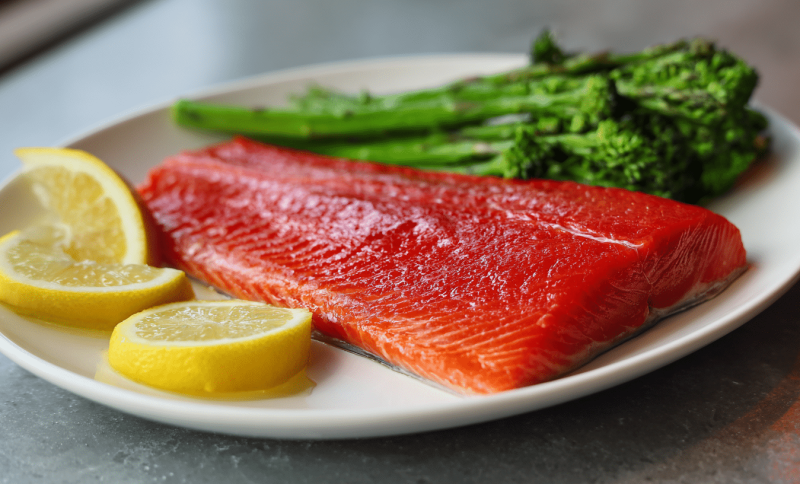Sockeye salmon stands out as one of nature’s most nutrient-dense foods, offering an incredible combination of high-quality protein, heart-healthy fats, and important vitamins and minerals.
This vibrant, deep-red fish isn’t just delicious; it’s a nutritional powerhouse that can significantly boost your health when included in a balanced diet.
What makes sockeye salmon special compared to other salmon varieties?
Its wild-caught nature, rich flavor, and superior nutritional profile set it apart from farm-raised alternatives.
Sockeye salmon has a firmer texture and more intense taste than other salmon types, making it a favorite among seafood lovers who want both exceptional nutrition and outstanding flavor in every bite.
What Makes Sockeye Salmon Nutritionally Superior?
Before diving into specific nutritional numbers, it’s worth understanding why sockeye salmon deserves a place on your plate.
Unlike many protein sources that offer limited nutritional benefits beyond basic macronutrients, sockeye salmon provides a complete package of nutrients that work together to support multiple aspects of your health.
From brain-boosting omega-3s to bone-building vitamin D, every serving delivers compounds your body needs to function at its best.
Sockeye Salmon Nutrition Facts: Complete Breakdown
Let’s examine exactly what nutrients you’re getting in each 100-gram serving and how they support your body’s daily needs.
1. Protein and Amino Acids
Sockeye salmon provides 27.3 grams of complete protein per 100-gram serving, containing all nine important amino acids your body needs.
This high-quality protein supports muscle maintenance, tissue repair, and immune function. The protein in sockeye salmon is easily digestible and efficiently used by your body.
Unlike plant proteins that often lack certain amino acids, salmon provides the complete protein profile needed for optimal health.
2. Healthy Fats and Omega-3s
With 11 grams of fat per serving, sockeye salmon provides moderate amounts of healthy fats, including 1.3 grams of omega-3 fatty acids.
These omega-3s, particularly EPA and DHA, support heart health, brain function, and reduce inflammation throughout your body.
The fat content gives sockeye salmon its rich flavor and helps your body absorb fat-soluble vitamins.
These healthy fats are one of the primary reasons nutrition experts recommend eating fatty fish at least twice a week.
3. Important Vitamins
Sockeye salmon excels in vitamin content, particularly Vitamin D with 360 IU per serving (90% of daily needs).
This is crucial since few foods naturally contain significant vitamin D, making salmon an important dietary source.
Vitamin B12 content is exceptional at 204% of daily needs, supporting nerve function and red blood cell formation. B6 and niacin help convert food into energy and support proper brain function throughout the day.
4. Key Minerals
Selenium leads the mineral content at 75% of daily needs, acting as a powerful antioxidant that protects cells from damage.
Potassium supports heart health and proper muscle function, while phosphorus works with calcium to build strong bones and teeth.
Though present in smaller amounts, magnesium, iron, and zinc contribute to various body functions, including immune support and energy production.
Complete Sockeye Salmon Nutrition Facts (Per 100g Cooked)
| Nutrient | Amount | % Daily Value* |
|---|---|---|
| Calories | 216 | – |
| Total Protein | 27.3g | 55% |
| Total Fat | 11g | 14% |
| Omega-3 Fatty Acids | 1.3g | – |
| Carbohydrates | 0g | 0% |
| Vitamin D | 360 IU | 90% |
| Vitamin B12 | 4.9mcg | 204% |
| Vitamin B6 | 0.6mg | 35% |
| Niacin (B3) | 8.5mg | 53% |
| Selenium | 41mcg | 75% |
| Potassium | 490mg | 10% |
| Phosphorus | 252mg | 36% |
| Magnesium | 30mg | 7% |
| Iron | 0.5mg | 3% |
| Zinc | 0.5mg | 5% |
*Percent Daily Values are based on a 2,000 calorie diet
Sockeye Salmon Health Benefits: What Science Shows
The impressive nutritional profile of sockeye salmon translates into real health benefits supported by scientific research.
Regular consumption of this nutrient-dense fish has been linked to several positive health outcomes that extend far beyond basic nutrition.
- Heart Health Support: Omega-3 fatty acids help reduce inflammation, lower blood pressure, and decrease heart disease risk.
- Brain Function Enhancement: DHA and EPA omega-3s support cognitive function, memory, and may reduce the risk of depression.
- Bone Health: High vitamin D content supports calcium absorption and bone mineralization. The combination of vitamin D, phosphorus, and protein makes sockeye salmon excellent for maintaining strong bones throughout life.
- Immune System Support: Selenium, vitamin D, and high-quality protein work together to support immune function. These nutrients help your body fight off infections and maintain overall health.
- Anti-Inflammatory Effects: Omega-3 fatty acids and astaxanthin (the compound that gives salmon its red color) have powerful anti-inflammatory properties. Regular consumption may help reduce chronic inflammation linked to various health conditions.
Safety and Freshness Considerations
Ensuring you buy and handle sockeye salmon safely protects both nutrition and health.
Look for bright red flesh color, clear (not cloudy) eyes if buying whole fish, and a firm texture that springs back when pressed. Fresh salmon should smell like the ocean, not “fishy” or ammonia-like.
Store fresh salmon in the coldest part of your refrigerator and use it within 1-2 days. For longer storage, wrap tightly and freeze for up to 3 months, with minimal nutrient loss.
Sockeye salmon is considered low in mercury compared to larger fish, such as tuna or shark. Most people can safely consume 2-3 servings per week without concerns about mercury.
Look for Alaska-caught wild sockeye salmon, which is sustainably managed and sourced. Avoid farmed salmon whenever possible, as it often contains lower levels of omega-3s and may have environmental concerns.
Where to Buy Quality Sockeye Salmon
Finding high-quality sockeye salmon ensures you get maximum nutritional benefits and the best flavor experience.
|
Best Sources: Reputable grocery stores with high seafood turnover, specialty seafood markets, and trusted online suppliers offer the freshest options. Costco and Whole Foods often have good-quality frozen sockeye salmon year-round. Fresh vs. Frozen: Both can be nutritionally excellent if handled properly. Frozen salmon is flash-frozen shortly after catch, preserving nutrients and allowing year-round availability. Buying Forms: Whole fish offers the best value but requires more preparation. Fillets provide convenience and are perfect for most home cooking. Canned sockeye salmon offers budget-friendly nutrition and convenience for salads and quick meals. |
Simple and Healthy Sockeye Salmon Recipes
Ready to put all this nutritional knowledge into practice? These simple recipes showcase sockeye salmon’s natural flavor while preserving its important nutrients for maximum health benefits.
- Grilled Sockeye with Lemon-Dill Sauce: Season the fillets with salt and pepper, grill for 4-5 minutes per side, and serve with a yogurt-based dill sauce.
- Baked Sockeye with Roasted Vegetables: Place salmon on a sheet pan with seasonal vegetables, drizzle with olive oil, and bake at 400°F for 12-15 minutes.
- Sockeye Salmon Poke Bowl: Cube raw sushi-grade salmon, serve over brown rice with avocado, cucumber, and sesame dressing.
- Salmon Quinoa Salad: Flake cooked salmon into quinoa salad with mixed greens, cherry tomatoes, and citrus vinaigrette for a complete meal.
Cooking Tips for Maximum Nutrition and Flavor
Proper cooking techniques preserve the nutritional content of sockeye salmon while creating delicious meals that your family will love.
| Cooking Method | Temperature | Time | Benefits |
|---|---|---|---|
| Baking | 400°F | 12-15 min | Preserves omega-3s, even cooking |
| Grilling | Medium heat | 4-5 min per side | Great flavor, maintains moisture |
| Poaching | 160-180°F | 8-10 min | Gentlest method, maximum nutrition |
| Broiling | High/6 inches away | 6-8 min | Quick cooking, crispy skin |
Always cook salmon to an internal temperature of 145°F for food safety while maintaining optimal texture and nutrition.
The Bottom Line on Sockeye Salmon Nutrition
Sockeye salmon delivers exceptional nutritional value with 27 grams of complete protein, heart-healthy omega-3 fatty acids, and important vitamins like D and B12 per serving.
While it costs more than basic proteins, the unique nutritional profile – particularly omega-3s and vitamin D that are hard to find in other foods – makes it a worthwhile investment in your health.
Focus on buying quality wild-caught salmon, store it properly, and use simple cooking methods to preserve its nutritional benefits and natural flavor.
What’s your favorite way to prepare sockeye salmon? Share your cooking tips and recipe ideas in the comments below!
















